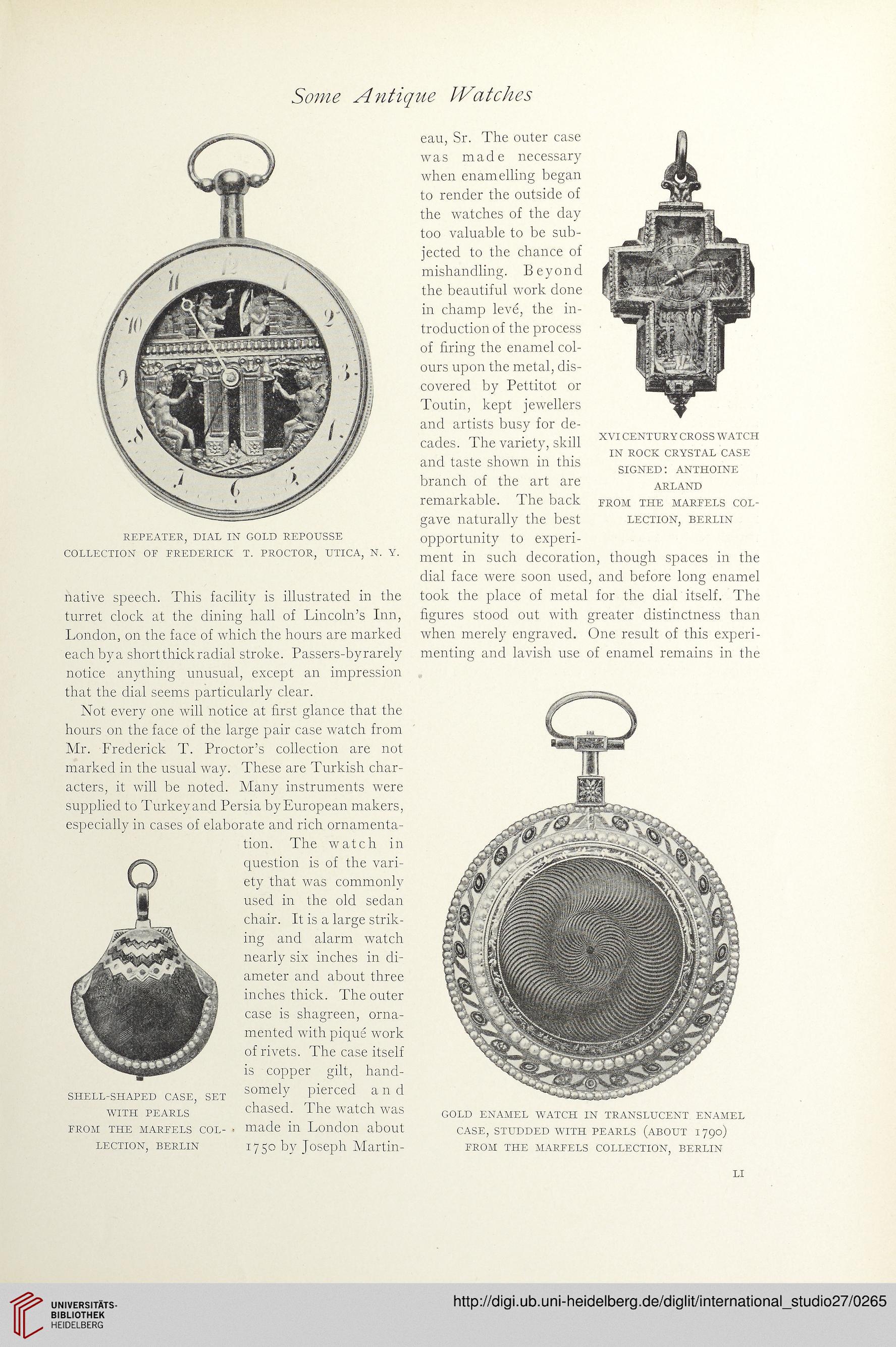Some Antique PVatcties
REPEATER, DIAL IN GOLD REPOUSSE
COLLECTION OF FREDERICK T. PROCTOR, UTICA, N. Y.
native speech. This facility is illustrated in the
turret clock at the dining hall of Lincoln’s Inn,
London, on the face of which the hours are marked
each bya shortthickradial stroke. Passers-byrarely
notice anything unusual, except an impression
that the dial seems particularly clear.
Not every one will notice at first glance that the
hours on the face of the large pair case watch from
Mr. Frederick T. Proctor’s collection are not
marked in the usual way. These are Turkish char-
acters, it will be noted. Many Instruments were
supplied to Turkey and Persia by European makers,
especially in cases of elaborate and rieh ornamenta-
tion. The watch in
question is of the vari-
ety that was commonly
used in the old sedan
chair. It is a large strik-
ing and alarm watch
nearly six inches in di-
ameter and about three
inches thick. The outer
case is shagreen, orna-
mented with pique work
of rivets. The case itself
is copper gilt, hand-
somely pierced and
chased. The watch was
made in London about
lection, Berlin 1750 by Joseph Martin -
SHELL-SHAPED CASE, SET
WITH PEARLS
eau, Sr. The outer case
was made necessary
when enamelling began
to render the outside of
the watches of the day
too valuable to be sub-
jected to the chance of
mishandling. B e y o n d
the beautiful work done
in champ leve, the in-
troduction of the process
of firing the enamel col-
ours upon the metal, dis-
covered by Pettitot or
Toutin, kept jewellers
and artists busy for de-
cades. The variety, skill
and taste shown in this
branch of the art are
remarkable. The back
gave naturally the best
opportunity to experi-
ment in such decoration, though spaces in the
dial face were soon used, and before long enamel
took the place of metal for the dial itself. The
figures stoocl out with greater distinetness than
XVI CENTURY CROSS WATCH
IN ROCK CRYSTAL CASE
signed: anthoine
ARLAND
FROM THE MARFELS COL-
LECTION, BERLIN
when merely engraved. One result of this experi-
menting and lavish use of enamel remains in the
GOLD ENAMEL WATCH IN TRANSLUCENT ENAMEL
CASE, STUDDED WITH PEARLS (ABOUT 1790)
FROM THE MARFELS COLLECTION, BERLIN
LI
REPEATER, DIAL IN GOLD REPOUSSE
COLLECTION OF FREDERICK T. PROCTOR, UTICA, N. Y.
native speech. This facility is illustrated in the
turret clock at the dining hall of Lincoln’s Inn,
London, on the face of which the hours are marked
each bya shortthickradial stroke. Passers-byrarely
notice anything unusual, except an impression
that the dial seems particularly clear.
Not every one will notice at first glance that the
hours on the face of the large pair case watch from
Mr. Frederick T. Proctor’s collection are not
marked in the usual way. These are Turkish char-
acters, it will be noted. Many Instruments were
supplied to Turkey and Persia by European makers,
especially in cases of elaborate and rieh ornamenta-
tion. The watch in
question is of the vari-
ety that was commonly
used in the old sedan
chair. It is a large strik-
ing and alarm watch
nearly six inches in di-
ameter and about three
inches thick. The outer
case is shagreen, orna-
mented with pique work
of rivets. The case itself
is copper gilt, hand-
somely pierced and
chased. The watch was
made in London about
lection, Berlin 1750 by Joseph Martin -
SHELL-SHAPED CASE, SET
WITH PEARLS
eau, Sr. The outer case
was made necessary
when enamelling began
to render the outside of
the watches of the day
too valuable to be sub-
jected to the chance of
mishandling. B e y o n d
the beautiful work done
in champ leve, the in-
troduction of the process
of firing the enamel col-
ours upon the metal, dis-
covered by Pettitot or
Toutin, kept jewellers
and artists busy for de-
cades. The variety, skill
and taste shown in this
branch of the art are
remarkable. The back
gave naturally the best
opportunity to experi-
ment in such decoration, though spaces in the
dial face were soon used, and before long enamel
took the place of metal for the dial itself. The
figures stoocl out with greater distinetness than
XVI CENTURY CROSS WATCH
IN ROCK CRYSTAL CASE
signed: anthoine
ARLAND
FROM THE MARFELS COL-
LECTION, BERLIN
when merely engraved. One result of this experi-
menting and lavish use of enamel remains in the
GOLD ENAMEL WATCH IN TRANSLUCENT ENAMEL
CASE, STUDDED WITH PEARLS (ABOUT 1790)
FROM THE MARFELS COLLECTION, BERLIN
LI





